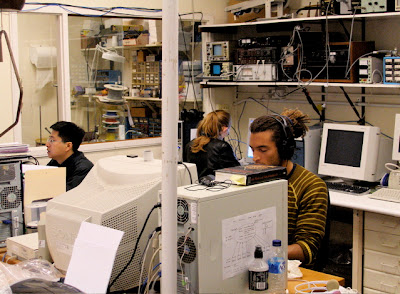On Wednesday, we spent most of the day making plans for our car trip: booking rental cars and the ferry to Tasmania, and confirming plans for meeting people along the way. In the afternoon we took a cab to the car rental agency in downtown Sydney (in the CBD) with my contra hard case, to make sure that the car we rented would hold my contra. Then we drove home to Coogee very carefully, on the left-hand side of the road.
There were so many little things to take care of that we didn’t get underway the next day until about 11:00 am, and even then, we had to make a stop at UNSW to pick up a fax that came in for Anne from Japan. But finally we were headed west, out of the city and towards Adelaide. We decided on a whim to go straight west over the Blue Mountains instead of driving the freeway past Canberra. The road up into the Blues was narrow and twisted, but finally we were in the hills and genuinely out of the city. Our first little side trip was to drive the little panorama road between Leura and Katoomba. We pulled into a turnoff at an overlook, and when we turned the car off we heard all kinds of birds in the forest that were fascinating. I don’t consider myself a birder, but the calls you hear from the birds in Australia are exotic and captivating.


We had a picnic lunch at the overlook of the famous “Three Sisters” and then continued on through the mountains. After a steep descent we were into the cattle and sheep grazing country of rolling hills, which was really picturesque countryside. We took Hwy 24, the Great Western Highway, from Bathurst all the way to Hay, and it was a marvelous drive. The road is not cut through the landscape. It twists, climbs and dives through the rolling hills, and each new hilltop reveals a new valley with its own flavor.

We stayed the first night in the historic town of Carcoar, which is the third-oldest town west of Sydney. White settlement there dates back to 1829, and the town is nestled in a compact valley. We stayed at a lovely B&B, and the proprieters told us it was “Roast Night” at the hotel restaurant. We walked over there and when we sat down we felt like we had stepped about 75 years back in time. What a contrast to bustling Sydney. It was a great meal, by the way.

At this B&B we learned that breakfast is usually provided in a basket the night before, so that you can have it whenever you like in the morning, in your room, and then be underway. We liked that system—it was always nice opening the basket to see what was in it.













